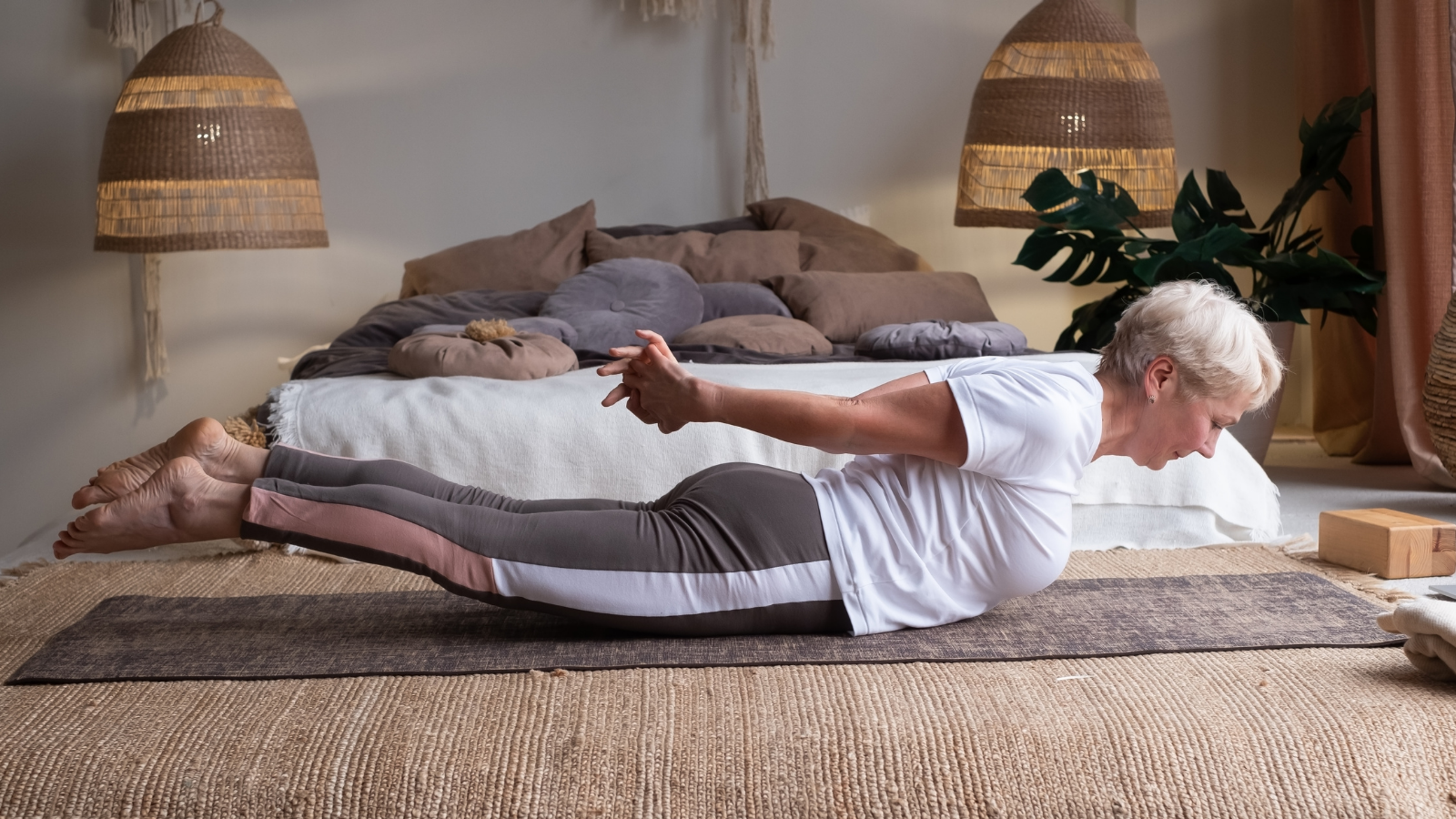Yoga for Osteoporosis: New Study Highlights the Safety Profile of Osteoporosis Drugs

If you have been diagnosed with osteoporosis or osteopenia, one of the first questions you probably have concerns the safety of osteoporosis drugs. In addition, many people wonder if alternative approaches to osteoporosis prevention, like yoga, can offer a viable alternative to preventing osteoporotic fractures.
With people over age 65 projected to outnumber those under 18 by 2034 for the first time in U.S. history, the prevention of age-related conditions like osteoporosis is becoming an increasingly pressing concern. (1)
For people looking to create a foundation for healthy aging, evaluating all the options is an important component of creating a strategy. This will offer the best benefits for preventing not just fractures, but also other common age-related problems affecting our mobility, freedom of movement, and ultimately, the ability to live independently.
A New Study Examines the Safety of Common Osteoporosis Drugs
How safe are today’s standard osteoporosis drugs?
A recent article published in the British Journal of Clinical Pharmacology offers a useful update on the safety profile of common osteoporosis drugs. (2)
The study reviewed the clinical data available on the short- and long-term safety of 6 common drugs used to treat osteoporosis. In their study, Danish professor Michael Kriegbaum Skjødt and colleagues paid close attention to the drugs’ side effects associated with long-term use. Since osteoporosis is a chronic condition, it generally requires long-term treatment, increasing the risk of side effects.
In their review, Kriegbaum Skjødt and colleagues classified osteoporosis drugs into two main categories:
- Antiresorptive Osteoporosis Drugs. These are drugs that block the activity of cells that break down bone tissue.
- Bone Anabolic Osteoporosis Drugs. These are drugs that promote bone remodeling and strengthening.
Below, we explore the authors’ main findings on side effects and safety concerns associated with each drug category.
Review of the Safety of Antiresorptive Osteoporosis Drugs

The most common antiresorptive drugs are bisphosphonates. These were introduced as a drug to promote bone strength nearly 50 years ago.
Common Side Effects of Bisphosphonates and Denosumab
Despite being widely used, bisphosphonate use has been linked to serious adverse events, including hip fractures and damage to the jaw that can require surgery to repair. These effects are also linked to the common antiresorptive osteoporosis drugs called denosumab. They are thought to occur as an unintended consequence of making bones overly hard or brittle.
Bisphosphonates may have other adverse effects, such as damage to the esophagus, musculoskeletal pain, and potential cardiac complications.
Bisphosphonates should also be avoided by individuals with kidney conditions as these individuals may not clear the drugs quickly enough from blood circulation. The drug denosumab may be safer for individuals with kidney conditions, but it should be avoided by anyone with hypoparathyroidism. In addition to previously mentioned adverse events, it may cause side effects such as gas and skeletal pain.
Common Side Effects of Selective Estrogen Receptor Modulators (SERMs)
The final class of antiresorptive drugs mentioned by the authors is selective estrogen receptor modulators (SERMs), which work by activating and/or blocking receptors for the hormone estrogen.
Raloxifene is the most commonly prescribed drug in this class, and research links it to side effects such as blood clots, hot flashes, leg cramps, and swelling of the lower legs and hands.
In postmenopausal women, raloxifene may also be linked to serious cardiac complications, such as deep vein thrombosis (serious blood clot in deep veins) and pulmonary embolism (blockage of arteries in the lungs).
More research is needed on bazedoxifene, another commonly prescribed drug in this category, but its side effects seem to be comparable to raloxifene.
Review of the Safety of Bone Anabolic Osteoporosis Drugs
Bone anabolic drugs prevent osteoporotic fractures by stimulating the formation of new bone cells. This is in contrast to the antiresorptive drugs, which increase bone mass by preventing the breakdown of old bone. While stimulating the formation of new bone would seem to be a preferable approach, this class of drugs also comes with numerous side effects.
Common Side Effects of Teriparatides and Abaloparatides
Teriparatide and abaloparatide are two commonly prescribed categories of drugs that work by enhancing the formation of new bone cells.
Side effects for both drug categories are similar and include dizziness, leg cramps, joint pain, nausea, and headache. In addition, teriparatide has been linked to a buildup of toxic blood levels of calcium. Abaloparatide has a lower risk of these serious adverse events. But the authors point to concerns with chronic exposure potentially being linked to certain forms of bone cancer.
Finally, romosozumab (Evenity) is an emerging drug category that seems to help with bone strengthening. Research is still underway, but it seems adverse events may be comparable to those seen in individuals prescribed teriparatide or abaloparatide. In addition, it seems romosozumab may be linked to a greater risk for cardiovascular complications compared with bisphosphonates.
Alternative Approaches to Preventing Osteoporosis and Fractures

In their recent publication, Kriegbaum Skjødt and colleagues showed that safety could vary across common osteoporosis drugs. And yet, all drugs they investigated were linked to an array of different side effects and adverse events.
If you have osteoporosis, consulting with your physician, reviewing this safety information, and reflecting on your personal health history can help you to decide which drug may be best suited for you.
To prevent osteoporosis and promote bone strength, regular physical activity such as yoga may be a better strategy. A study published in 2016 by Dr. Loren Fishman and colleagues showed a yoga regimen as short as 12 minutes daily to reverse osteoporotic bone loss. (3)
In an interview with Dr. Fishman, he cited a multitude of additional benefits of yoga for individuals at-risk or diagnosed with osteoporosis. These benefits include improved muscular strength, balance, range of motion, and coordination, all while reducing anxiety.
Research on yoga as an approach to preventing osteoporosis and fractures is continuing to unfold. And yet, in his own experience providing nearly 30,000 hours of yoga practices to individuals over age 65, Dr. Fishman says he hasn’t seen a single incidence of fracture. For this reason, yoga may be worthwhile to consider as a safe strategy for prevention for anyone at risk for osteoporosis and fractures.
Also, read...
Do Yoga and Meditation Reduce Health-Care Utilization? What Studies Say
Jun 30 – By: B Grace Bullock, PhD, E-RYT 500
Age-Related Posture Slump? Yoga Can Help Alleviate Hyperkyphosis, Study Suggests
Jun 29 – Eve Johnson
How Exercise Might Help Brain and Nervous System Health
Feb 20 – Nina Zolotow, RYT 500
Related courses
Breath as Medicine: Yogic Breathing for Vital Aging
With Doug Keller
Yoga and Myofascial Release: Releasing Chronic Tension with the Bodymind Ballwork Method
With Ellen Saltonstall
Yoga and Detoxification: Tips for Stimulating Lymphatic Health
With Lisa Levitt Gainsley

Lacey Ramirez writes for YogaUOnline and is an RYT-500 & ERYT-200 yoga teacher, global health researcher, and writer based in St. Louis. Through her work, she seeks to make yoga accessible, inclusive, and equitable.
Lacey discovered yoga as a tool for centering during her years as a competitive runner. Since then, yoga has served as a way to connect with her body throughout her experience of pregnancy and parenthood. She teaches because she hopes others can use this sacred practice for calming, healing, and transformation.
As a yoga teacher, Lacey specializes in teaching restorative, Yin, prenatal, and trauma-informed Vinyasa yoga. She has also completed birth doula and prenatal/postnatal barre certifications and trainings. Additionally, she holds a Masters of Science in Global Health and Population from Harvard T.H. Chan School of Public Health. To learn more and connect, visit her website laceyramirez.com
Resources:
- https://www.census.gov/newsroom/press-releases/2018/cb18-41-population-projections.html
- https://www.ncbi.nlm.nih.gov/pmc/articles/PMC6533454/
- https://www.ncbi.nlm.nih.gov/pmc/articles/PMC4851231/
Recent articles
Fascia and the Vagus Nerve: Healing from the Inside Out
Jul 10 – Dr. Arielle Schwartz
Change Your Perspective of Pelvic Tilting: How the Transversus Abdominis Can Help
Jul 08 – Olga Kabel C-IAYT
Warrior I Pose: 5 Strengthening Variations
Jul 02 – Bridget Frederick, eRYT 500
Categories
Upcoming courses
Breath as Medicine: Yogic Breathing for Vital Aging
With Doug Keller
Yoga and Myofascial Release: Releasing Chronic Tension with the Bodymind Ballwork Method
With Ellen Saltonstall
JOIN NOW!
Recent articles
Almost there...
Sorry, we couldn't find anything...
Stress Relief
Fascia and the Vagus Nerve: Healing from the Inside Out
Have you ever had a morning in which you woke up with a painful…
Jul 10 – Dr. Arielle Schwartz
Pose Library
Change Your Perspective of Pelvic Tilting: How the Transversus Abdominis Can Help
“Tuck your tailbone under” or “lengthen your tailbone” have long been among the most…
Jul 08 – Olga Kabel C-IAYT
Yoga Practice Tips
Warrior I Pose: 5 Strengthening Variations
Warrior I Pose (Virabhadrasana I) is an excellent pose for strengthening your whole back…
Jul 02 – Bridget Frederick, eRYT 500



